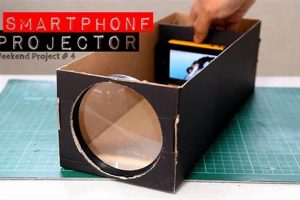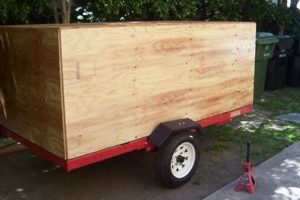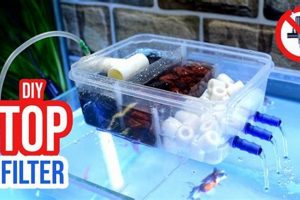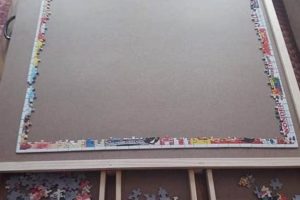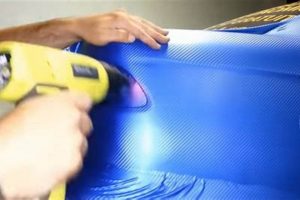An upholstered panel affixed to the head of a bed frame, often constructed at home, provides both aesthetic and functional benefits to a bedroom. This method allows for customization of the bed’s appearance using various textiles and designs, offering a personalized alternative to commercially manufactured options. For example, a homeowner may choose a specific color and pattern of fabric to complement existing dcor or create a unique focal point in the room.
Implementing this creative endeavor yields several advantages. Primarily, it presents a cost-effective way to enhance bedroom aesthetics compared to purchasing pre-made, often expensive, headboards. Furthermore, it allows for the incorporation of personal style and preferences into the bedroom design, resulting in a more individualised and comfortable space. Historically, headboards have served functional purposes such as insulation and protection; modern interpretations largely focus on decorative appeal.
The subsequent sections will detail the required materials, construction processes, and design considerations necessary for successful project completion. Guidance will be provided on selecting appropriate materials, cutting and assembling components, and attaching the finished product to a bed frame, or a wall, providing comprehensive resources to enable the reader to undertake this decorative and functional enhancement.
Essential Construction Strategies
Optimizing the creation process requires careful planning and execution. The following guidelines serve to enhance the longevity, aesthetic appeal, and structural integrity of the finished product.
Tip 1: Fabric Selection: Prioritize durable, upholstery-grade textiles. Natural fibers such as linen and cotton blends offer both longevity and visual appeal. Verify the fabric’s resistance to abrasion and fading prior to commencement.
Tip 2: Frame Integrity: Construct the frame utilizing robust materials, such as hardwood plywood or solid wood. Ensure accurate measurements and square corners for a stable and aesthetically pleasing outcome. Reinforce joints with wood glue and screws.
Tip 3: Padding Consistency: Employ high-density foam for consistent padding across the entire surface. Inconsistent padding results in an uneven surface and diminished aesthetic quality. Use spray adhesive to secure foam to the frame.
Tip 4: Precise Upholstery: Employ upholstery techniques to ensure smooth and even fabric application. Use a staple gun with sufficient power to penetrate both the fabric and the frame securely. Maintain consistent tension to eliminate wrinkles or sags.
Tip 5: Button Placement: When incorporating buttons, utilize a consistent spacing pattern and secure them firmly to the frame. Inconsistent button placement detracts from the overall design. Utilize upholstery thread and a long needle for secure attachment.
Tip 6: Edge Finishing: Conceal raw edges with gimp, decorative trim, or piping. This enhances the aesthetic appeal and prevents fraying. Apply trim using fabric glue or staples, ensuring a seamless transition.
Tip 7: Attachment Methods: Select a secure attachment method appropriate for the bed frame or wall. Options include using mounting brackets, French cleats, or direct bolting. Ensure secure and stable mounting to prevent movement or detachment.
Adherence to these strategies facilitates the creation of a visually appealing, structurally sound, and long-lasting bedroom furnishing. By attending to detail in material selection, construction, and finishing, it will be a valuable addition to the bedroom’s design scheme.
The following section will offer advice on customizing its design to complement diverse bedroom aesthetics, focusing on various styles and finishing touches.
1. Frame Construction
The structural framework constitutes a foundational element of the project, directly influencing its stability, longevity, and overall aesthetic quality. Attention to detail during this phase is critical for achieving a satisfactory and durable end product.
- Material Selection
Choice of material significantly impacts the frame’s strength and weight. Solid wood offers robustness but can be heavier and more expensive. Plywood provides a balance of strength, affordability, and ease of use. The selected material should be free from defects, such as knots or warping, to ensure a stable and uniform surface. For instance, using warped lumber risks a distorted appearance and compromised structural integrity.
- Dimensional Accuracy
Precise measurements and accurate cuts are essential for a square and symmetrical frame. Inaccurate dimensions can lead to uneven fabric stretching and an unprofessional finish. Utilizing accurate measuring tools and a square ensures that all corners are at 90-degree angles, resulting in a structurally sound and visually appealing frame. A frame with uneven dimensions detracts from the final appearance and may compromise its functionality.
- Joint Strength
Secure joints are vital for maintaining the frame’s structural integrity over time. Common joint types include butt joints reinforced with screws, miter joints for angled corners, and mortise-and-tenon joints for superior strength. Proper joint construction prevents wobbling, sagging, or eventual frame failure. For example, poorly constructed joints are prone to loosening over time, compromising the overall structural integrity.
- Surface Preparation
Preparing the frame surface prior to upholstery is crucial for achieving a smooth and even finish. Sanding the frame eliminates splinters and sharp edges, preventing damage to the fabric. Applying a sealant or primer can protect the wood from moisture and prevent discoloration. A well-prepared surface ensures that the fabric adheres properly and provides a professional appearance. Skipping this step may result in an uneven finish and potential fabric damage.
The interrelation of material selection, dimensional accuracy, joint strength, and surface preparation determines the ultimate success of this endeavor. A meticulously constructed frame provides a solid base for upholstery, enhancing both the aesthetic appeal and longevity of this home furnishing.
2. Fabric Selection
The selection of fabric constitutes a pivotal decision in the creation of a headboard. This decision impacts the aesthetic qualities, durability, and overall longevity of the finished piece. Careful consideration of various fabric characteristics is essential to achieve a satisfactory and enduring outcome.
- Durability and Wear Resistance
The selected material’s resistance to abrasion, fading, and stretching determines its long-term performance. Fabrics intended for high-use applications, such as seating
or bedding, should exhibit a high level of durability. For instance, upholstery-grade fabrics are specifically designed to withstand significant wear and tear, making them a suitable choice. Conversely, delicate or loosely woven materials may be prone to damage and are less suitable for this purpose. The ability to withstand wear directly influences the lifespan of the upholstered panel. - Aesthetic Properties and Style
The fabric’s color, pattern, and texture contribute significantly to the overall aesthetic appeal. The chosen fabric should complement the existing bedroom decor and reflect the individual’s stylistic preferences. Neutral tones and subtle patterns provide a versatile backdrop, while bold colors and intricate designs create a focal point. The aesthetic properties must align with the desired ambiance of the room. For example, linen provides a rustic texture and subdued color palette. Velvet offers a plush, luxurious appearance. The integration of aesthetic properties is key to achieving the desired visual effect.
- Maintenance and Cleanability
Ease of maintenance is a practical consideration, particularly for items subject to frequent use or potential staining. Fabrics that are easily cleaned and resistant to stains simplify upkeep and prolong the product’s lifespan. Some materials are inherently stain-resistant, while others may require special treatments or cleaning methods. For example, synthetic microfiber fabrics often exhibit good stain resistance. Natural fibers, such as cotton, may require protective coatings. The choice of material should balance aesthetic preferences with practical maintenance requirements.
- Cost and Availability
The cost of the selected material influences the overall project budget. Fabric prices vary widely depending on fiber content, weave, and design complexity. Availability may also be a limiting factor, particularly for specialized or imported materials. Balancing cost considerations with desired aesthetic and performance characteristics is essential. For instance, readily available cotton blends are a cost-effective choice. Premium materials, such as silk or leather, command a significantly higher price. Budgetary constraints should guide material selection while optimizing aesthetic outcomes.
Ultimately, the successful integration of these facets ensures that the fabric selection enhances the overall design and functionality of the finished product. A careful evaluation of these considerations contributes to a harmonious blend of aesthetics, durability, and practicality, resulting in a long-lasting and visually appealing addition to the bedroom decor.
3. Padding Density
Padding density directly influences the aesthetic appearance, comfort level, and longevity of a fabric headboard constructed at home. A causal relationship exists: insufficient padding results in a thin, potentially lumpy surface that detracts from the overall visual appeal. Conversely, excessively dense padding may create an overly bulky and disproportionate profile. As a component, appropriate padding density is crucial because it provides the desired cushioning effect and supports the fabric, preventing sagging or wrinkling over time. Consider two examples: a headboard with low-density foam will likely show the underlying frame structure and feel hard, while one with high-density foam will present a smooth, plush surface, offering superior comfort when leaning against it.
The practical significance lies in the tactile experience and the durability of the finished product. Denser padding generally retains its shape and resilience longer than less dense options. In practice, selecting a medium- to high-density foam (around 2-3 pounds per cubic foot) for a headboard allows for comfortable support and minimizes the risk of compression over extended use. This choice not only enhances the user experience but also extends the lifespan of the headboard by preventing premature wear and tear on the fabric and the padding itself. Considerations such as the thickness of the foam and the type of fabric being used must be accounted for when selecting density. A thinner fabric may necessitate denser foam to avoid a see-through effect, while a thicker fabric may require less dense foam to prevent an overly stiff appearance.
In summary, achieving optimal padding density presents a key challenge in headboard creation. Finding the appropriate balance involves assessing fabric characteristics, desired comfort levels, and long-term durability requirements. The successful integration of correct padding density is integral to the visual appeal, tactile comfort, and sustained quality of the final product, directly contributing to the overall value and satisfaction derived from the home furnishing. While achieving the exact optimal density may require experimentation, understanding the core principles is essential for achieving favorable results.
4. Upholstery Technique
Upholstery technique represents a critical skillset in the successful creation of a fabric headboard. The proficiency with which fabric is applied, secured, and finished directly influences the visual appeal, durability, and overall quality of the final product. Mastery of these techniques transforms raw materials into a finished, aesthetically pleasing, and structurally sound component.
- Fabric Tensioning and Alignment
Maintaining consistent fabric tension during application is paramount to prevent wrinkles, sagging, or distortion of the fabric pattern. Proper alignment ensures that patterns are straight and symmetrical, contributing to a professional and polished appearance. An example includes the use of upholstery stretchers to evenly distribute tension across the fabric as it is stapled to the frame. Inadequate tension results in an amateurish look, whereas proper tensioning creates a smooth, taut surface.
- Stapling and Fastening Methods
The method used to secure the fabric to the frame directly impacts the longevity of the upholstery. Upholstery staples, strategically placed and properly driven, provide a secure hold without damaging the fabric. Techniques such as blind stapling, where staples are concealed beneath the fabric, enhance the aesthetic quality. The implications of improper stapling range from fabric pulling away from the frame to visible and unsightly fasteners.
- Cornering and Edge Finishing
Corners and edges present unique challenges in upholstery. Achieving clean, crisp corners and neatly finished edges requires specific techniques, such as folding, pleating, or using specialized tools. Examples include creating mitered corners for a professional look or using gimp trim to conceal raw edges. Neglecting these details results in a less refined and potentially unraveling finish.
- Button Tufting and Detailing
Incorporating design elements such as button tufting adds visual interest and texture. Precise button placement and secure attachment are essential for achieving a uniform and aesthetically pleasing pattern. Proper tufting techniques prevent buttons from pulling through the fabric or becoming loose over time. Inconsistent or poorly executed tufting detracts from the overall design and compromises the structural integrity of the upholstery.
These facets of upholstery technique, when skillfully applied, elevate a proje
ct from rudimentary to professional quality. Consistent attention to detail in fabric tensioning, fastening methods, cornering, and detailing is essential for a successful project outcome. The selection and execution of appropriate upholstery techniques directly determine the aesthetic appeal, durability, and overall quality of the finished product, transforming raw materials into a lasting, aesthetically pleasing, and functional addition to any bedroom.
5. Design Customization
The inherent characteristic of a self-fashioned upholstered panel lies within the realm of design customization. This element distinguishes a personally constructed item from mass-produced alternatives. The ability to tailor dimensions, fabric selections, and stylistic details allows for integration with diverse bedroom aesthetics. A direct causal relationship exists: the degree of customization directly impacts the finished product’s ability to complement or enhance a specific interior design scheme. For instance, a minimalist bedroom may benefit from a simple, linen-covered design, while a more elaborate aesthetic may incorporate button tufting and patterned fabrics. The ability to control these variables provides significant advantages.
Considering practical applications, customized dimensions address unique spatial constraints. A narrow bedroom may necessitate a shorter panel, while a larger room allows for a more expansive design. Fabric selection provides opportunity to reflect personal style or complement existing textiles within the space. Furthermore, detailing, such as incorporating nailhead trim or contrasting piping, adds visual interest and individualized flair. This adaptability is crucial for homeowners seeking to create a cohesive and personalized environment. For example, a homeowner might replicate a design seen in a magazine but adjust the dimensions and fabric to suit their specific requirements and preferences.
In conclusion, customization is central to the appeal and value of a “fabric headboard”. It enables the creation of a unique and personalized furnishing that harmonizes with a specific bedroom aesthetic. Challenges exist in balancing personal expression with principles of design, but the ability to control these aspects offers significant potential for creating a visually striking and functionally appropriate element within a home. The core advantage remains the opportunity to create a truly one-of-a-kind element, tailored to the individual’s specific needs and aesthetic sensibilities.
6. Attachment Method
The secure and stable connection of a self-constructed upholstered panel to a bed frame or wall represents a crucial final step in fabrication. The selected attachment method directly impacts the headboard’s stability, safety, and aesthetic integration within the bedroom environment. Improper attachment can result in instability, damage to the bed frame or wall, and a compromised overall appearance.
- Bed Frame Compatibility
Diverse bed frame designs necessitate varied attachment strategies. Standard metal frames often feature pre-drilled holes for headboard mounting, allowing for direct bolting. Wooden frames may require the installation of mounting brackets or the use of wood screws. Consideration of frame construction is essential for selecting appropriate hardware and ensuring a secure fit. Attempting to attach a panel designed for a metal frame to a wooden frame without proper adaptation can compromise stability and lead to structural damage.
- Wall Mounting Considerations
Wall-mounted installations offer flexibility in positioning and eliminate reliance on the bed frame. However, wall mounting requires careful assessment of wall construction and the use of appropriate anchors. Drywall, plaster, and concrete walls necessitate different types of anchors to ensure a secure and lasting hold. Failure to use appropriate anchors can result in the headboard detaching from the wall, posing a safety hazard and potentially damaging the wall surface.
- Weight Distribution and Support
The weight of the upholstered panel must be evenly distributed to prevent stress on the attachment points. Large or heavy headboards may require multiple attachment points or the use of support structures to distribute the load. Inadequate weight distribution can cause the headboard to sag or pull away from the frame or wall over time, compromising its stability and appearance.
- Concealment of Hardware
The visibility of attachment hardware can detract from the aesthetic appeal of the finished product. Concealed mounting systems, such as French cleats or recessed brackets, provide a clean and professional appearance. Careful planning and execution are necessary to ensure that the hardware is securely fastened while remaining hidden from view. Exposed hardware can diminish the aesthetic quality and undermine the overall design intent.
The selection and implementation of an appropriate attachment method are indispensable for ensuring the stability, safety, and aesthetic integration of a fabric headboard. Consideration of bed frame compatibility, wall construction, weight distribution, and hardware concealment is essential for achieving a successful and enduring installation. The attachment method represents the final link between the crafted headboard and its functional integration within the bedroom, directly influencing its performance and visual impact.
7. Finishing Details
The selection and application of appropriate finishing details significantly elevate the aesthetic quality and perceived value of a “diy fabric headboard”. These details, while often subtle, contribute substantially to a refined and professional outcome, distinguishing a handcrafted item from mass-produced alternatives. Thoughtful execution of these elements enhances the overall design and ensures a polished, long-lasting product.
- Trim Selection and Application
The choice of trim, such as gimp braid, piping, or nailhead trim, offers an opportunity to define the edges and enhance the visual appeal of the headboard. Trim selection should complement the fabric and overall design style. Precise application is crucial for a seamless and professional appearance. For example, unevenly applied gimp braid can detract from the overall aesthetic, while a neatly applied trim provides a clean and polished edge. The correct trim choice improves the visual impact of the upholstered panel.
- Button Detailing and Placement
The incorporation of buttons, whether functional or decorative, adds texture and visual interest. Button placement requires careful planning to achieve a symmetrical and balanced design. The use of covered buttons, matching or contrasting the fabric, provides a cohesive and upscale appearance. For instance, randomly placed or poorly secured buttons detract from the overall design, while strategically positioned and securely fastened buttons enhance the aesthetic appeal. Thoughtful button detailing elevates the craftsmanship of the headboard.
- Backing and Dust Cover Application
The application of a backing fabric,
such as muslin or cambric, protects the back of the headboard, concealing the raw edges of the upholstery and providing a clean finish. A dust cover prevents the accumulation of dust and debris, enhancing the longevity and hygiene of the product. Properly applied backing and dust covers contribute to a professional and refined appearance. Neglecting this detail can expose unsightly staples and raw edges, diminishing the overall quality. - Hardware Concealment
The concealment of mounting hardware, such as brackets or screws, is essential for maintaining a clean and uncluttered aesthetic. Recessed mounting systems or fabric-covered hardware offer discreet attachment solutions. Attention to this detail ensures that the focus remains on the design of the headboard, rather than the method of attachment. Exposed hardware detracts from the overall visual appeal, while concealed hardware contributes to a polished and professional finish.
These finishing details, when thoughtfully considered and skillfully executed, transform a simply constructed item into a personalized and visually appealing bedroom furnishing. The refinement achieved through careful attention to trim, button detailing, backing, and hardware concealment elevates the perceived value and aesthetic appeal of a DIY fabric headboard, providing a lasting and satisfying addition to the home.
Frequently Asked Questions
The following questions address common inquiries and concerns related to designing and constructing a fabric headboard.
Question 1: What is the minimum recommended thickness for the foam padding?
A minimum thickness of 2 inches is generally recommended for foam padding. This thickness provides adequate cushioning and prevents the underlying frame from being visible through the fabric. Thicker padding may be used for a plusher appearance and feel; however, excessive thickness can distort the overall shape.
Question 2: Which fabric types are most resistant to staining and wear?
Upholstery-grade microfiber and synthetic blends exhibit superior resistance to staining and wear. These materials are tightly woven, making them less susceptible to liquid absorption and abrasion. Natural fibers, such as linen and cotton, may require stain-resistant treatments to enhance their durability.
Question 3: What is the optimal spacing for buttons in a tufted design?
Optimal button spacing is contingent upon the size and design of the headboard. As a general guideline, buttons should be spaced evenly, typically ranging from 4 to 8 inches apart. Consistency in spacing is crucial for achieving a balanced and visually appealing tufted pattern. Trial and error is required.
Question 4: How does one prevent fabric slippage during the upholstery process?
To prevent fabric slippage, utilize a spray adhesive to secure the fabric to the foam padding and frame. The application of adhesive provides a temporary bond, facilitating accurate alignment and tensioning during stapling. Ensure the adhesive is specifically designed for upholstery applications to avoid damage to the fabric or foam.
Question 5: What type of wood is recommended for constructing the frame?
Hardwood plywood or solid hardwood, such as poplar or oak, is recommended for constructing the frame. These materials provide sufficient strength and stability to support the upholstery. Softwoods, such as pine, are less durable and may be prone to warping or splitting under stress.
Question 6: How is the risk of mold and mildew growth minimized in a humid environment?
To minimize the risk of mold and mildew growth, select fabrics with inherent moisture resistance or apply a fabric protector with antimicrobial properties. Ensure adequate ventilation in the bedroom to reduce humidity levels. Avoid placing the headboard against damp walls or in areas prone to condensation.
These frequently asked questions provide a foundational understanding of key considerations in fabrication. Adherence to these guidelines will improve the likelihood of a successful outcome.
The subsequent section will focus on troubleshooting common challenges and offering solutions to address potential issues.
DIY Fabric Headboard
This article has presented a comprehensive overview of design and construction, underscoring the critical aspects of material selection, structural integrity, upholstery techniques, and finishing details. Understanding these elements is essential for those seeking to create a durable, aesthetically pleasing, and personalized bedroom furnishing. Successful execution requires meticulous planning and attention to detail throughout the entire process.
The information serves as a foundation for further exploration and experimentation, empowering individuals to confidently approach fabrication. Mastering these skills allows for the creation of valuable household items, tailored to precise requirements and aesthetic sensibilities. The pursuit of such endeavors not only enhances living spaces but also fosters self-sufficiency and creative expression.


